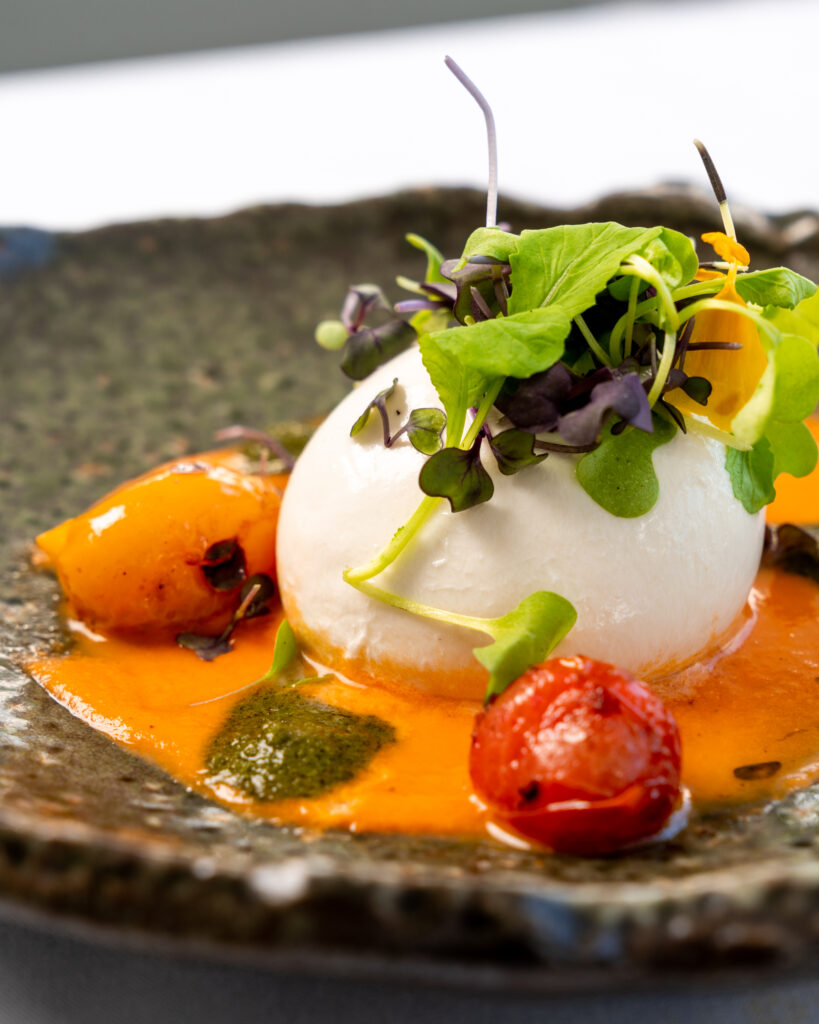Why Sustainable Menu Options Matter for Today’s Restaurants
Sustainable menu options are food and beverage offerings designed to minimize environmental impact while maximizing nutritional benefits and business performance. Here’s what makes a menu sustainable:
- Plant-forward focus: At least 75% vegetarian items
- Local and seasonal sourcing: Ingredients from within 250 miles
- Reduced food waste: Creative use of whole ingredients
- Ethical sourcing: Fair trade, organic, sustainable seafood
- Transparent practices: Clear information about food origins
The food we serve has a massive impact. Our current food systems are failing both people and the planet. The way we produce and consume food is responsible for around one-third of total global greenhouse gas emissions, while one in five deaths globally are linked to poor diet.
Restaurants and foodservice operations feed millions of people every day, giving them significant power to shape eating habits and social norms. When Cambridge University researchers doubled the availability of vegetarian dishes on menus, they saw a remarkable 40-80% increase in sales of these dishes—without hurting overall revenue.
The good news? Making menus more sustainable isn’t just good for the environment. Evidence shows it can reduce operating costs by up to 30%, attract eco-conscious customers, and boost staff retention. As one industry executive noted after implementing sustainable menu changes: “It’s a MUST for teams looking for environmentally friendly menu innovations in a business-savvy way.”
Whether you run a neighborhood café or manage foodservice for a major institution, sustainable menu options represent one of your biggest opportunities to reduce environmental impact while building a stronger business.

Must-know sustainable menu options terms:
– farm-to-table dining experiences
– food sustainability trends
– sustainable dining practices
What Makes a Menu “Sustainable” (and Why It Matters)
Have you ever wondered what actually makes a restaurant menu truly sustainable? Here at The Dining Destination, we’ve been watching this change unfold across New York City’s vibrant food scene and beyond. Today’s forward-thinking restaurants are embracing a beautiful balance—creating sustainable menu options that delight diners, boost their bottom line, and help heal our planet.
Definition & Scope of Sustainable Menu Options
Creating a sustainable menu goes far beyond tossing in a single veggie burger or salad. Research shows that to meaningfully shift dining choices, menus need at least 75% vegetarian offerings. This principle drives exciting initiatives like #50by25, which challenges restaurants to transform half their menu to plant-based options by the end of 2025.
The brilliant minds at the Culinary Institute of America and Harvard’s T.H. Chan School of Public Health have developed the Menus of Change principles that give restaurants a clear roadmap. These guidelines emphasize honest transparency about where food comes from, putting plants at the center of the plate, embracing whole foods over heavily processed ones, featuring responsibly-sourced seafood, cutting back on sugar and salt, and rethinking portion sizes.
“The principles unite nutritional and environmental science to inform optimal menu design in foodservice,” a Menus of Change representative told us recently. “It’s not about eliminating choice, but about making the sustainable choice the default one.”
Environmental & Public-Health Imperatives
The case for embracing sustainable menu options becomes clearer every day. Our global food systems generate roughly one-third of all greenhouse gas emissions, with animal agriculture being a major contributor. According to compelling research in the Journal of Environmental Psychology, shifting our collective eating habits toward more plant-based choices is now an urgent environmental priority.
The health stakes are equally high. Over 40% of people worldwide simply cannot afford nutritious food, and poor diet is linked to one in every five deaths globally. We’re living in a paradoxical world where 783 million people go hungry while 2.6 billion are overweight or obese—a heartbreaking illustration of how broken our food system has become.
By thoughtfully implementing sustainable menu options, restaurants and food providers can address both environmental and health challenges at once. As one sustainability expert beautifully put it: “Restaurants can shape social norms and thus influence home eating habits over time.”

Profit Meets Purpose: The Business Case for Going Green
Let’s be honest – running a restaurant isn’t just about passion, it’s about staying profitable. The exciting news? Embracing sustainable menu options can actually boost your bottom line while helping the planet. It’s that rare win-win we’re all searching for.
Revenue & Marketing Advantages
The numbers tell a compelling story about sustainability’s impact on sales. When Cambridge University researchers simply doubled the vegetarian options available, they saw vegetarian sales jump by a remarkable 40-80%. That’s not just good for the environment—it’s great for business.
Today’s diners vote with their wallets. About 58% of Millennials actively seek out restaurants with sustainable sourcing practices, and more than two-thirds of customers are willing to pay extra when they know a restaurant is committed to green practices.
Carbon labeling is becoming the new calorie count on forward-thinking menus. Sweetgreen has pioneered this approach, displaying CO2E (carbon equivalent) metrics alongside nutritional info for each dish.
“I was skeptical at first,” admits a chef from a popular New York eatery who recently added carbon metrics to their menu. “But we’ve seen a 15% increase in orders of our lowest-carbon dishes since adding these little numbers. Customers genuinely care about this stuff.”
Smart restaurants are also turning sustainability into loyalty. Some clever operators now offer extra points or special discounts when customers choose plant-based options or bring their own takeout containers. It’s a simple way to reward the behavior that benefits everyone.
Operational Efficiencies & Risk Reduction
Beyond bringing in more customers, sustainable menu options can significantly cut your operating costs:
Food waste reduction through creative repurposing can trim food costs by up to 10%. Think about that—one-tenth of your food budget back in your pocket just by being smarter about using what you already buy.
Seasonal bulk purchasing not only supports local farmers but often means better prices for your restaurant. Plant-forward menus typically cost less to produce than meat-heavy ones, and energy-efficient cooking methods can make a noticeable difference in your utility bills.
A thorough waste audit can reveal surprising opportunities. One restaurant owner shared: “We were literally throwing money in the trash. Those broccoli stems we used to toss now become a delicious slaw that customers love. We’re saving thousands annually while creating a popular new menu item.”
Strategic menu design focused on high-margin, low-carbon items can increase profits by up to 15%. And here’s something often overlooked: restaurants committed to sustainable practices typically enjoy lower employee turnover. In an industry where staffing challenges are constant, this benefit alone can save thousands in recruitment and training costs.

Sustainability isn’t just a moral choice anymore—it’s becoming an essential business strategy for restaurants that want to thrive in our changing world.
Building Sustainable Menu Options: A Step-by-Step Framework
Creating sustainable menu options isn’t something that happens with the snap of your fingers. It’s more like cooking a perfect risotto—methodical, intentional, and requiring attention at every stage. Let’s walk through our practical framework that’s helped restaurants transform their menus without sacrificing flavor or profits.
Step 1 – Source Smart & Local
The journey toward sustainability begins at the source—your ingredients. When you source locally, you’re not just reducing carbon emissions from transportation; you’re supporting your community’s economic ecosystem.
“We define locally produced foods as those grown or produced within 250 miles,” explains Maria Chen, a sustainable sourcing consultant I spoke with recently. “But even hyperlocal—think rooftop gardens or urban farms—can make a meaningful difference.”
Consider building relationships at your local farmers’ market, where you can meet producers face-to-face. One New York chef told me, “My Saturday morning market visits have become my menu planning sessions. I see what looks best that week and build dishes around it.” This approach naturally leads to seasonal rotations that highlight produce at its peak flavor and lowest cost.
For seafood choices, the Monterey Bay Aquarium’s Seafood Watch guide remains the gold standard. Bamboo Sushi demonstrates how powerful these certifications can be—they’ve built their entire brand around sustainable sourcing partnerships with organizations like the Marine Stewardship Council.
Step 2 – Design for Flavor-First Plants
Here’s the secret that successful plant-forward menus understand: lead with flavor, not virtue. Nobody chooses a dish because it’s good for the planet—they choose it because it sounds delicious.
“We found that leading with flavor in menu descriptions rather than health claims drives far more sales,” shares a chef who participated in Menus of Change research. “People eat with their taste buds first, their conscience second.”
Build your plant-forward dishes around satisfying proteins like legumes and whole grains. Add depth with umami-rich ingredients—mushrooms, fermented foods, aged cheeses—that create that “I can’t believe this is mostly vegetables” reaction. For flexitarian diners, consider blended approaches like burgers with 30% mushrooms that reduce meat without eliminating it entirely.
A Brooklyn chef shared her experience: “I finded carrot top pesto while trying to reduce kitchen waste. Now it’s one of our signature items—guests rave about the bright, herbaceous flavor, and I love sharing that we’re using the whole vegetable.” For more on maximizing flavor with local ingredients, explore our guide on Why Locally Sourced Ingredients Make a Difference.
Step 3 – Reduce Food Waste Creatively
When nearly half of all fruits and vegetables end up wasted, tackling food waste isn’t just environmentally responsible—it’s a huge financial opportunity for your restaurant.
Root-to-leaf cooking transforms what might have been trash into culinary treasure. Banana peels become crispy chips when washed, seasoned, and baked. Watermelon rinds transform into tangy pickles. Corn cobs, once discarded, make flavorful stock that lifts risotto to new heights. Broccoli stems become crunchy slaw, citrus peels turn into marmalade, and herb stems blend into vibrant chimichurri.
“At our last dinner party, friends couldn’t stop talking about the pumpkin guts hummus,” confides Chef James from Seattle. “What was once scraped into the compost is now roasted into a sweet, smoky spread that people can’t get enough of.”
Simple storage practices make a big difference too. Label everything with dates, keep fruits and vegetables in their proper places, and religiously practice “first in, first out” to minimize spoilage.
Step 4 – Set Portions & Pricing for Health and Margin
The size of your plate directly impacts your profits and your planet. Research shows that smaller plates (9-10 inches instead of the standard 12) create an optical illusion that satisfies customers while reducing food waste and costs.
“We made a simple change that transformed our business,” explains restaurant owner Sarah. “We reduced our steak portion from 8 to 5 ounces but upgraded the quality of the meat and added more colorful, local vegetables to the plate. Our food costs dropped while our Yelp reviews improved.”
Consider reframing value around quality rather than quantity. Gradually reduce sodium by 10-20% across recipes (your customers won’t notice if done incrementally). Cut added sugar in desserts and replace sugary drinks with house-made infused waters that cost pennies to produce.
Your pricing should reflect the true value of sustainable ingredients while maintaining healthy margins. Many successful restaurants price their plant-forward dishes slightly lower than meat options to encourage selection, while charging premium prices for sustainably sourced animal proteins.
Step 5 – Train Staff & Tell the Story
Even the most thoughtfully designed sustainable menu options need champions. Your staff are your sustainability ambassadors, turning principles into profits through their interactions with guests.
“Our servers make or break a guest’s willingness to try our plant-forward dishes,” notes a restaurant manager in Chicago. “When they can authentically describe the flavor profile and share the story behind an ingredient, diners are much more likely to order outside their comfort zone.”
Invest time in developing front-of-house scripts that highlight both flavor and sustainability stories. Conduct regular tastings so staff can genuinely recommend dishes they’ve experienced. Create transparency around sourcing with detailed information about farms and producers that staff can share.
Bamboo Sushi exemplifies this storytelling approach. Their menu and website feature detailed profiles of each seafood supplier, helping diners feel connected to the source of their meal and understanding why sustainable choices matter.

Menu Psychology: Nudges That Make Sustainable Choices the Easy Choices
Have you ever wondered why you choose certain dishes when dining out? It’s not just about what you’re craving. The way a menu is designed can gently guide your choices without you even realizing it. Smart restaurants use this menu psychology to encourage diners to select sustainable menu options while still giving them complete freedom of choice.
The impact of these subtle nudges is impressive. Research from Cambridge University finded that simple menu interventions can drive an astonishing 85% uptake in vegetarian choices. These aren’t heavy-handed tactics – they’re thoughtful designs that make sustainable choices feel natural and appealing.
Use Language to Sell Sustainable Menu Options
Words matter – especially on a menu. The language used to describe a dish can completely transform how appealing it seems. According to the World Resources Institute, choosing the right words can boost sales of plant-based dishes by up to 70%.
“Restrictive language on menus like ‘meat-free’ or ‘low-fat’ should be avoided in favor of sensory or provenance descriptors,” explains a menu design expert I spoke with recently. “Customers eat with their eyes first, then their imagination, and finally their mouths.”
Consider the difference between these two descriptions: “Vegan Mushroom Burger” versus “Umami-Rich Portobello Burger with Caramelized Onions and House-Made Aioli.” The second focuses on flavor rather than dietary restriction, making it appealing to all diners, not just those following a plant-based diet.
Effective language strategies that work wonders include using sensory words that evoke taste and texture, highlighting the specific farms where ingredients come from, avoiding labels like “vegan” or “meat-free,” and focusing on what dishes include rather than what they lack. These small shifts in language can make sustainable menu options the most tempting choices on your menu.
Layout & Defaults That Drive Uptake of Sustainable Menu Options
The physical layout of your menu and how options are presented play crucial roles in guiding diners toward sustainable choices. One powerful approach is ensuring at least 75% of your menu features plant-forward options – this is the threshold where research shows significant behavior change happens.
Placing your most sustainable dishes at the top of each menu section takes advantage of the “primacy effect” – people tend to remember and choose items they see first. Using highlight boxes or chef’s recommendation symbols for plant-forward dishes also draws the eye and suggests quality.
Perhaps the most effective strategy is making sustainable choices the default option. The Greener by Default approach exemplifies this perfectly – plant-based food is the standard offering, with meat available as an optional add-on. This preserves complete freedom of choice while gently nudging toward sustainability.
“Making plant-based dishes the default option can drive down emissions without restricting consumer choice,” a Greener by Default representative told me. This approach has been successfully implemented at major institutions like Harvard University and NYC Health + Hospitals, proving that small changes in menu design can have significant environmental impacts.

Measuring Impact & Scaling Success
Let’s face it—what gets measured gets managed. If you’re serious about sustainable menu options, you need to track your progress and celebrate your wins along the way.
Tools & Benchmarks
The good news? You don’t have to reinvent the wheel. Several proven tools can help you measure just how sustainable your menu really is.
The Event Food Carbon Calculator has become a go-to resource for many restaurants I’ve worked with. It lets you plug in different ingredients and portion sizes to see the carbon footprint of your dishes. One chef in Brooklyn told me, “It was eye-opening—I could instantly see which ingredients were climate bombs and which were heroes.”
When setting targets, aim for the World Wildlife Fund’s recommended benchmark of keeping meals under 0.5 kg CO2e per person. This gives your kitchen team a clear north star to work toward when designing new dishes.
Beyond carbon, waste-tracking software can be transformative. A restaurant owner in Manhattan shared, “We started weighing our kitchen scraps daily, and suddenly everyone became waste-conscious. We’ve cut our trash volume by 40% in six months.” The visibility creates accountability.
Don’t forget to measure what matters most to your business, too. Track these essential KPIs:
- Carbon footprint per meal (the environmental bottom line)
- Percentage of plant-based menu items (aim for that critical 75% threshold)
- Food waste reduction by weight and value (dollars saved)
- Sales figures comparing sustainable vs. conventional options
- Customer satisfaction ratings (proving sustainability doesn’t sacrifice enjoyment)
“When we started tracking these numbers, we turned sustainability from a vague concept into a business strategy with measurable returns,” explained one restaurant group director.
Industry Collaborations & Competitions
You don’t have to go it alone. Joining forces with industry initiatives provides structure, resources, and well-deserved recognition for your sustainable menu journey.
The annual Menus of Change Leadership Summit has become the must-attend event for forward-thinking foodservice leaders. “I came back from the summit with ten actionable ideas we implemented within a month,” shared a catering director. “The ROI was immediate.”
For the competitive spirits out there, the Repurposed Solution Competition rewards creative approaches to food waste. Past winners have turned carrot tops into pesto and coffee grounds into mushroom growing medium—innovations that save money while reducing environmental impact.
Consider joining the #50by25 campaign, which challenges restaurants to transition to 50% plant-based menus by December 2025. It’s an ambitious but achievable goal that puts you in good company. Wagamama, the popular Asian-inspired chain, has already hit the 50% plant-based mark back in 2021, proving it’s entirely possible for mainstream restaurants to lead the way.
The data from these collaborations speaks volumes: restaurants participating in structured sustainability programs report not just environmental benefits, but an average 12% increase in revenue and 15% reduction in operating costs. As one chef put it, “Being part of something bigger keeps us accountable and gives us bragging rights when we hit our targets.”

Frequently Asked Questions about Sustainable Menu Options
How can I start if my current menu is meat-heavy?
If your restaurant currently features a meat-centric menu, don’t worry—you don’t need to transform everything overnight. Small, thoughtful changes can make a big difference in your sustainability journey.
Start by looking at your existing menu with fresh eyes. Which dishes could easily incorporate more vegetables or smaller portions of meat? Perhaps your bestselling pasta dish could feature seasonal vegetables with meat as a garnish rather than the star.
“Less is truly more when it comes to menu size—fewer dishes mean deeper sustainability focus,” advises a restaurant consultant I spoke with recently. Instead of maintaining a large menu with a few token sustainable options, consider streamlining your offerings to focus on quality and sustainability.
Try introducing one new sustainable menu option each week, giving your kitchen team time to perfect it and your servers time to become confident in recommending it. Reducing meat portions while adding more vegetables and whole grains is another effective strategy—many guests won’t even notice the difference if the flavor is there.
Remember to bring your staff along on this journey. When servers genuinely believe in and understand your sustainable menu options, they become your most powerful advocates.
Will customers pay more for sustainable dishes?
The short answer is yes—but with some important nuances. Research consistently shows that many diners are willing to pay a premium for sustainability, with over two-thirds of customers indicating they would pay extra for green restaurant practices. This is especially true among Millennials and Gen Z diners, who often prioritize environmental values when choosing where to eat.
However, transparency is essential. If you’re charging more for a dish because it features sustainably caught seafood or organic produce, make sure guests understand the value behind that price tag.
A seafood restaurant owner in Portland told me: “We explain that our sustainable seafood costs more because it supports responsible fishing practices. When customers understand the value, they’re generally willing to pay for it.”
A balanced approach to pricing works best. Consider offering some affordable plant-based options alongside premium-priced sustainable proteins. This creates multiple entry points for guests interested in making more sustainable choices, regardless of their budget.
What KPIs should I track first?
Measuring the impact of your sustainable menu options doesn’t have to be complicated. Start with these five foundational metrics:
First, track your menu composition—what percentage of your dishes are plant-based or plant-forward? This simple metric gives you a clear baseline and target for improvement.
Second, monitor food waste by measuring the weight of discarded food per customer. This highlights opportunities for more efficient ingredient use and creative repurposing.
Third, analyze your sales mix to understand which sustainable options are resonating with customers and which might need refinement.
Fourth, gather customer feedback specifically about your sustainable offerings. Are they satisfying? Would guests order them again?
Finally, measure your ingredient sourcing—what percentage comes from local producers within 250 miles?
“What gets measured gets managed,” a sustainability director at a major hotel chain told me recently. “Start with just a few key metrics and build from there as your program matures.”
As your sustainable menu program evolves, you can add more sophisticated measurements like carbon footprint calculations or detailed waste tracking by category, but these five metrics provide an excellent foundation for meaningful progress.
Conclusion
Let’s be honest—the restaurant industry is at a turning point. Sustainable menu options aren’t just a passing trend or a nice marketing angle anymore. They’ve become essential for restaurants that want to stay relevant and profitable in a world where diners increasingly vote with their forks.
Here at The Dining Destination, we’ve had front-row seats to watch New York City’s culinary scene transform. From cozy neighborhood spots to those impossible-to-book Michelin-starred restaurants, the most successful establishments share a common thread: they’ve finded that doing good for the planet can also do wonders for their bottom line.
“When we first started adding more plant-based dishes, I worried about alienating our regular customers,” confides one Brooklyn chef we interviewed. “But three years later, those plant-forward options are our bestsellers—and our food costs are down 15%.”
The journey toward sustainability doesn’t have to be overwhelming. Maybe you start by sourcing just one ingredient locally. Perhaps you experiment with a “root-to-stem” special that transforms would-be waste into a delicious dish. Or you might simply rearrange your menu to highlight the plant-forward options you already offer.
What matters most is taking that first step. As your confidence grows, you can implement more elements of our framework—smarter sourcing, flavor-first plant dishes, creative waste reduction, thoughtful portion sizing, and compelling storytelling.
Sustainable menu options represent a rare win-win-win opportunity: better for your business, better for your customers’ health, and better for our shared planet. In a restaurant industry known for razor-thin margins and fierce competition, sustainability offers a powerful way to differentiate your business while contributing to something larger than yourself.
The food system change is already happening. The question isn’t whether menus will become more sustainable—it’s whether your restaurant will help lead the change or struggle to catch up later.
Ready to dive deeper into sustainable dining culture? Explore our comprehensive guide on Sustainable Dining: More Than a Trend and find how to incorporate these principles into your next culinary trip.
The future of food is sustainable, delicious, and profitable. Come join us at the table.








1 thought on “Why Sustainable Menu Options Are Good for Business and the Planet”
Pingback: An Essential Guide to Crawfish: Facts, Habitat, and Identification - The Dining Destination
Comments are closed.